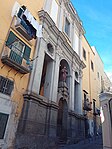Crypta Neapolitana
Archaeological sites in NaplesHistory of NaplesRoman roads in ItalyStreets in Naples

The Crypta Neapolitana (Latin for "Neapolitan crypt") is an ancient Roman road tunnel near Naples, Italy. It was built in 37 BC and is over 700 metres long. The tunnel connected Naples with the so-called Phlegrean Fields and the town of Pozzuoli along the road known as the via Domiziana.
Excerpt from the Wikipedia article Crypta Neapolitana (License: CC BY-SA 3.0, Authors, Images).Crypta Neapolitana
Salita della Grotta, Naples Chiaia
Geographical coordinates (GPS) Address Nearby Places Show on map
Geographical coordinates (GPS)
| Latitude | Longitude |
|---|---|
| N 40.829595 ° | E 14.21755 ° |
Address
Parco Vergiliano - Tomba di Virgilio
Salita della Grotta
80122 Naples, Chiaia
Campania, Italy
Open on Google Maps










